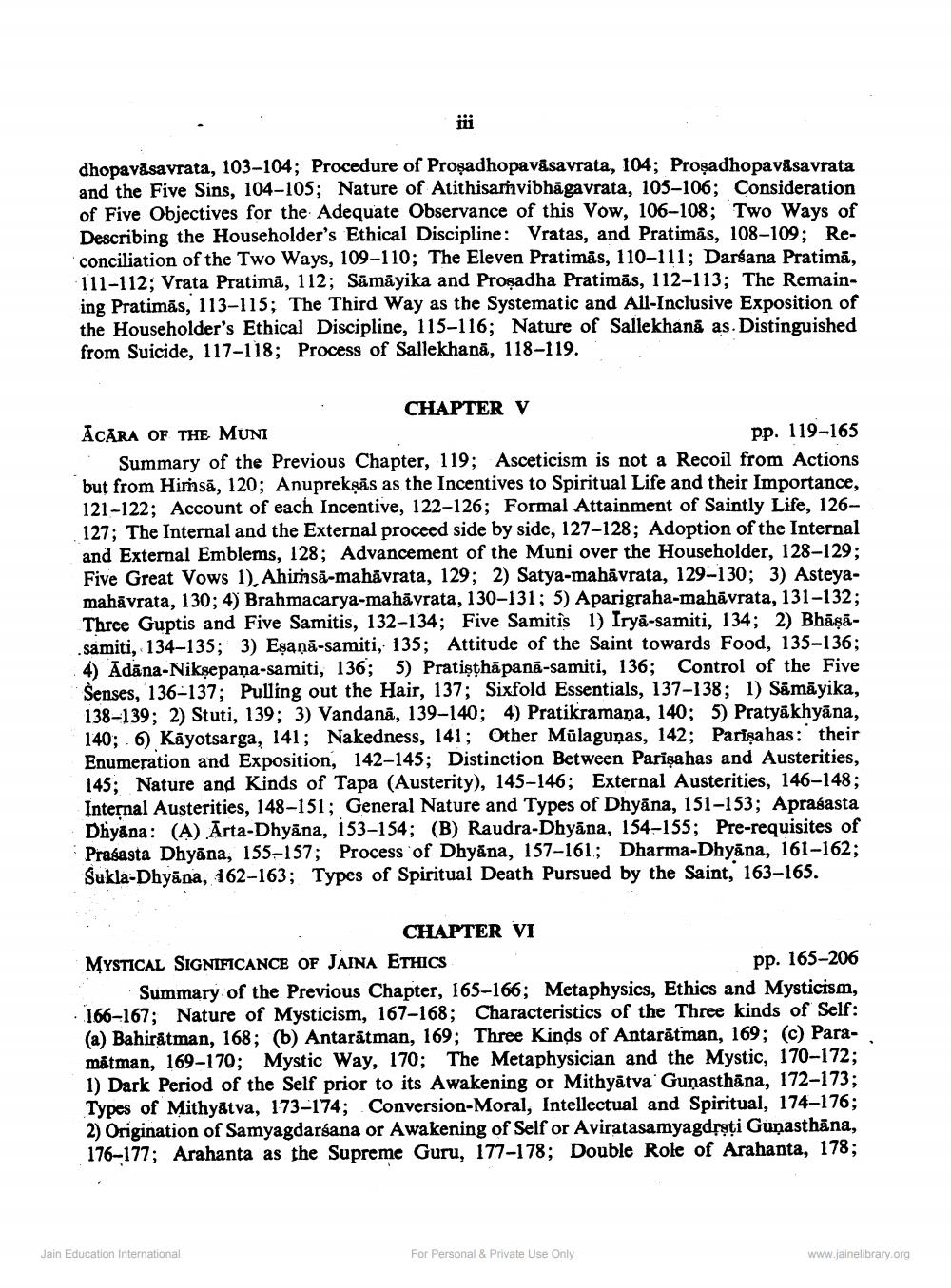________________
dhopavasavrata, 103-104; Procedure of Proşadhopavāsa vrata, 104; Proşadhopavāsavrata and the Five Sins, 104-105; Nature of Atithisarvibhāgavrata, 105-106; Consideration of Five Objectives for the Adequate Observance of this Vow, 106-108; Two Ways of Describing the Householder's Ethical Discipline: Vratas, and Pratimās, 108-109; Reconciliation of the Two Ways, 109-110; The Eleven Pratimās, 110-111; Darsana Pratimă, 111-112; Vrata Pratimā, 112; Sāmāyika and Prosadha Pratimās, 112-113; The Remaining Pratimās, 113-115; The Third Way as the Systematic and All-Inclusive Exposition of the Householder's Ethical Discipline, 115-116; Nature of Sallekhană as. Distinguished from Suicide, 117-118; Process of Sallekhanā, 118-119.
CHAPTER V ĀCĀRA OF THE MUNI
pp. 119-165 Summary of the Previous Chapter, 119; Asceticism is not a Recoil from Actions but from Hiṁsā, 120; Anuprekşās as the Incentives to Spiritual Life and their Importance, 121-122; Account of each Incentive, 122-126; Formal Attainment of Saintly Life, 126127; The Internal and the External proceed side by side, 127-128; Adoption of the Internal and External Emblems, 128; Advancement of the Muni over the Householder, 128-129; Five Great Vows 1), Ahimsa-mahāvrata, 129; 2) Satya-mahāvrata, 129-130; 3) Asteyamahāvrata, 130; 4) Brahmacarya-mahāvrata, 130-131; 5) Aparigraha-mahāvrata, 131-132; Three Guptis and Five Samitis, 132-134; Five Samitis 1) Iryā-samiti, 134; 2) Bhāsāsamiti, 134-135; 3) Eşaņā-samiti, 135; Attitude of the Saint towards Food, 135-136; 4) Adana-Niksepaņa-samiti, 136; 5) Pratisthāpanā-samiti, 136; Control of the Five Senses, 136-137; Pulling out the Hair, 137; Sixfold Essentials, 137-138; 1) Sāmāyika, 138-139; 2) Stuti, 139; 3) Vandanā, 139-140; 4) Pratikramana, 140; 5) Pratyākhyāna, 140; Kāyotsarga, 141; Nakedness, 141; Other Mūlaguņas, 142; Parişahas: their Enumeration and Exposition, 142–145; Distinction Between Parişahas and Austerities, 145; Nature and kinds of Tapa (Austerity), 145-146; External Austerities, 146-148; Internal Austerities, 148-151; General Nature and Types of Dhyāna, 151-153; Aprasasta Dhyana: (A) Arta-Dhyāna, 153-154; (B) Raudra-Dhyāna, 154-155; Pre-requisites of Prasasta Dhyāna, 155-157; Process of Dhyāna, 157-161; Dharma-Dhyāna, 161-162; Sukla-Dhyāna, 162-163; Types of Spiritual Death Pursued by the Saint, 163-165.
CHAPTER VI MYSTICAL SIGNIFICANCE OF JAINA ETHICS
pp. 165-206 Summary of the Previous Chapter, 165-166; Metaphysics, Ethics and Mysticism, · 166-167; Nature of Mysticism, 167-168; Characteristics of the Three kinds of Self:
(a) Bahirâtman, 168; (b) Antarătman, 169; Three Kinds of Antarātman, 169; (c) Paramåtman, 169-170; Mystic Way, 170; The Metaphysician and the Mystic, 170-172; 1) Dark Period of the Self prior to its Awakening or Mithyātva Gunasthāna, 172-173; Types of Mithyātva, 173-174; Conversion-Moral, Intellectual and Spiritual, 174-176; 2) Origination of Samyagdarsana or Awakening of Self or Aviratasamyagdrști Gunasthāna, 176-177; Arahanta as the Supreme Guru, 177-178; Double Role of Arahanta, 178;
Jain Education International
For Personal & Private Use Only
www.jainelibrary.org




